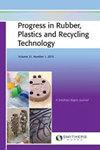再生PP与再生PET共混物的熔体加工行为及结构发展
IF 1.6
4区 材料科学
Q4 MATERIALS SCIENCE, COMPOSITES
Progress in Rubber Plastics and Recycling Technology
Pub Date : 2022-12-14
DOI:10.1177/14777606221145703
引用次数: 0
摘要
将市售的再生聚丙烯(R-PP)和再生瓶级聚对苯二甲酸乙二醇酯(R-PET)以不同比例的R-PET在双螺杆挤出机中熔融复合,温度通常用于PP加工。用毛细管流变仪研究了这些共混物在不同温度(230、250、260℃)下的熔体流动行为。采用DSC和XRD对其结晶和结构发展进行了研究。这些共混物的熔体粘度(η)遵循通常的非牛顿行为,高剪切速率(γ′)时η降低,低剪切速率时η饱和。最值得注意的是,熔体温度为230和250时,随着R-PET含量的增加,低剪切粘度达到峰值,而在260℃时,随着R-PET的加入,粘度均匀下降。高剪切粘度也表现出类似的变化趋势,但变化幅度较小。根据Utracki模型,这是由于区域形状从球形到椭球体,最后是纤维形状的交叉。在熔体复合/加工温度为230℃时,R-PET相处于半固态,因此在PP熔体中形成纤维状形态,SEM分析证实了这一点。最有趣的发现是,由于另一种聚合物的存在,两种聚合物的结晶都受到了影响。当R-PET存在时,R-PP表现出成核效应,温度从118℃向123℃升高。在R-PP的作用下,R-PET的温度也发生了从178℃到201℃的变化。这些结果从PP熔体中PET畴的成核和缓慢散热以及剪切诱导结晶的角度进行了讨论。R-PP/R-PET共混物中的这些结构修饰导致在特定条件下加工的某些组合物的性能得到改善。本文章由计算机程序翻译,如有差异,请以英文原文为准。
Melt processing behaviour and structure development in recycled PP blends with recycled PET
Commercially available recycled polypropylene (R-PP) and recycled bottle grade polyethylene terephthalate (R-PET) were melt compounded in different proportions of R-PET in twin screw extruder at temperatures used typically for PP processing. The melt flow behaviour was investigated for these blends using capillary rheometer at different temperatures viz. 230, 250, 260°C. The crystallization and structure development was studied using DSC and XRD. The melt viscosity (η) of these blends followed the usual non-Newtonian behaviour with decrease of η with high shear rate (γ′) and saturation at low shear rate. Most noteworthy finding was that the low shear viscosity at melt temperatures of 230 and 250 showed a peak with increase of R-PET content while at 260°C there was uniform decrease in the viscosity with addition of R-PET. The high shear viscosity also showed similar trend but with less pronounced changes. This was attributed to the cross over of domain shape from spherical to ellipsoidal and finally fibrous shape according to Utracki model. At the melt compounding/processing temperature of 230°C, the R-PET phase was in semi solid state and hence it formed fibrous morphology in the PP melt which was confirmed by SEM analysis. The most interesting finding was that crystallization of both the component polymers was affected due to the presence of the other. R-PP showed nucleation effect in presence of R-PET with the shift in Tc from 118°C to higher temperature side (123°C). Even R-PET exhibited shift in the Tc from 178°C to 201°C in presence of R-PP. These results are discussed in terms of nucleation and slow heat dissipation for PET domain in PP melt together with shear induced crystallization. These structural modifications in the R-PP/R-PET blends led to improvement in properties at certain compositions processed under certain conditions.
求助全文
通过发布文献求助,成功后即可免费获取论文全文。
去求助
来源期刊

Progress in Rubber Plastics and Recycling Technology
MATERIALS SCIENCE, COMPOSITES-POLYMER SCIENCE
CiteScore
4.40
自引率
7.70%
发文量
18
审稿时长
>12 weeks
期刊介绍:
The journal aims to bridge the gap between research and development and the practical and commercial applications of polymers in a wide range of uses. Current developments and likely future trends are reviewed across key areas of the polymer industry, together with existing and potential opportunities for the innovative use of plastic and rubber products.
 求助内容:
求助内容: 应助结果提醒方式:
应助结果提醒方式:


